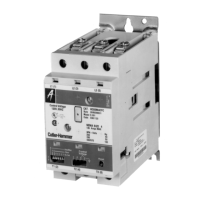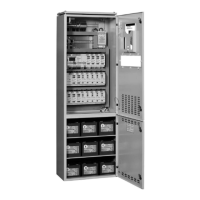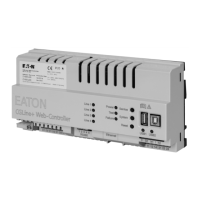IB01602009E For more information visit: www.eatonelectrical.com
Instruction Booklet
Effective: April 2004 Page 3
ATC-300 Automatic
Transfer Switch
Controller
Designed to meet the needs of markets worldwide, the
ATC-300 Controller:
■ Is a UL Recognized Component
■ Complies with UL 1008/ CSA 22.2-178
■ Meets the Intent of UL 991
■ Meets IEC 1000-4-2, 1000-4-3, 1000-4-4, 1000-4-5,
1000-4-6, and 1000-4-11
■ Meets CISPR 11, Class A
■ Complies with FCC Part 15, Class A
■ Meets European Standards Conformance (CE mark)
The ATC-300 Controller provides an unmatched degree of
programmed flexibility to address the needs of any system. It
operates from all system voltages between 120 and 600 Vac,
single-phase and 3-phase, at 50 or 60 Hz. In addition, a
period of no control power operation is provided. The ATC-
300 Controller monitors the condition of the 3-phase line-to-
line voltage and frequency of both the Source 1 and Source 2
power sources. It can also be programmed for single-phase
operation. The ATC-300 Controller provides the necessary
intelligence to insure that the switch operates properly
through a series of programmed sensing and timing functions.
A standard ATC-300 Controller will:
■ Monitor Source 1 and Source 2 power source voltages and
frequencies;
■ Provide undervoltage monitoring of the Source 1 and
Source 2 power sources;
■ Permit customer programming;
■ Display real-time and historical information;
■ Permit system testing;
■ Store customer/factory established parameters in nonvola-
tile memory; and
■ Provide faceplate source status indications.
1.4 Glossary
With respect to their use within this document and as they
relate to ATS and controller operation, the following terminol-
ogy is defined.
Available
A source is defined as “available” when it is within its under-
voltage/overvoltage/ underfrequency/overfrequency (if appli-
cable) setpoint ranges for the nominal voltage and frequency
setting.
Connected
Connected is defined as when the input is shorted by an
external contact or connection.
Failed or Fails
A source is defined as “failed” when it is outside of the appli-
cable voltage and frequency setpoint ranges for the nominal
voltage and frequency setting for a time exceeding 0.5 sec-
onds after the time delay emergency fail (TDEF) time delays
expires.
Failsafe
Failsafe is a feature that prevents disconnection from the only
available power source and also forces a transfer or re-trans-
fer operation to the only available power source.
Re-Transfer
Re-transfer is defined as a change of the load connection
from the Source 2 to the Source 1.
Source 1
Source 1 is the primary source (normal source, normal power
source, or normal).
Source 2
Source 2 is the secondary source (emergency source, emer-
gency power source, emergency, standby, or backup source).
Source 1: Failed or Fails
Source 1 is defined as “failed” when it is outside of its under-
voltage/overvoltage/ underfrequency/overfrequency (if appli-
cable) setpoint ranges for the nominal voltage and frequency
setting.
Source 2: Failed or Fails
Source 2 is defined as “failed” when it is outside of its under-
voltage/overvoltage/ underfrequency/overfrequency (if appli-
cable) setpoint ranges for the nominal voltage and frequency
setting for a time exceeding 0.5 seconds after the TDEF time
delay expires.
Transfer
Transfer is defined as a change of the load connection from
the Source 1 to the Source 2 power source, except when
specifically used as “Transfer to Neutral”.
Transfer to Neutral
Transfer to neutral is defined as when the load circuits are
disconnect from both the Source 1 and Source 2 power
sources.
Unconnected
Unconnected is defined as when the input is not shorted by
an external contact or connection.
V
IN, RMS
Refers to the operating input voltage (Vac, RMS).
1.5 Functions/Features/Options
The primary function of ATC-300 Controller is to accurately
monitor power sources and provide the necessary intelligence
to operate an ATS in an appropriate and timely manner. In
addition, the ATC-300 Controller provides programming
through the device’s faceplate or communication option.
1.5.1 Operational Simplicity
From installation to programming to usage, the ATC-300
Controller was designed with operational simplicity in mind.
Only one style needs to be considered, regardless of input/
output requirements or system voltages and frequencies. The
ATC-300 Controller provides the functionality of numerous
other devices combined in one package that mounts in 6.5 by
8.5 inches of panel space.
The user-friendly front panel interface simplifies routine oper-
ation, programming, data presentation, and setting adjust-
ments. An LCD-based display provides the flexibility of a
back-lit display for enhanced visibility. The operation of the
front panel membrane pushbuttons move the ATC-300 Con-
troller display from function to function or step to step within
a function.

